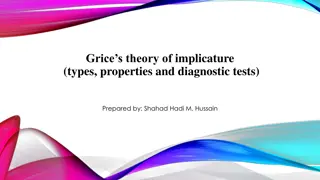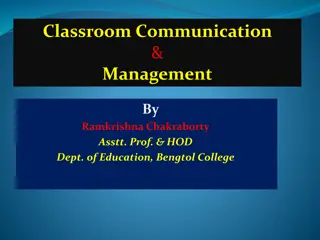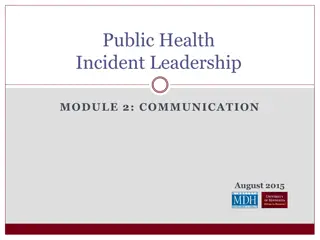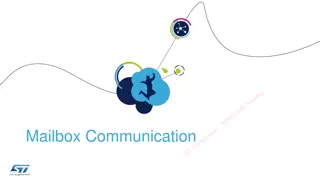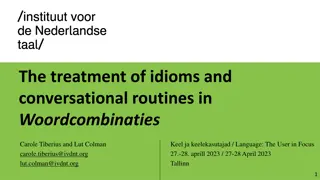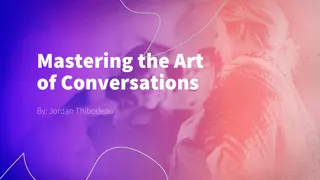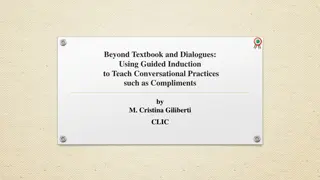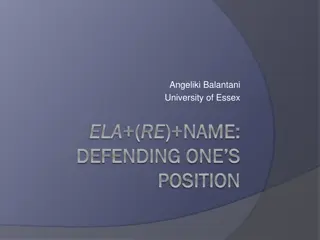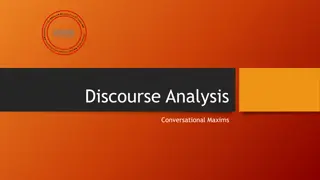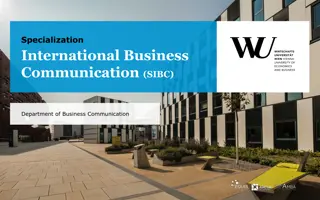Understanding Conversational Analysis: Insights into Everyday Communication
Exploring the realm of conversational analysis, this text delves into the significance of natural conversation and its role in language research. Through various approaches, such as conversational analysis and discourse analysis, researchers aim to uncover the linguistic characteristics and norms of everyday interactions. Pioneered by scholars like Sacks, Schegloff, and Jefferson in the 1970s, this field focuses on the spontaneous nature of social conversations, shedding light on turn-taking, conversational norms, and other facets of spoken interaction.
- Conversational Analysis
- Language Research
- Discourse Analysis
- Everyday Communication
- Linguistic Characteristics
Download Presentation

Please find below an Image/Link to download the presentation.
The content on the website is provided AS IS for your information and personal use only. It may not be sold, licensed, or shared on other websites without obtaining consent from the author. Download presentation by click this link. If you encounter any issues during the download, it is possible that the publisher has removed the file from their server.
E N D
Presentation Transcript
Conversation has been of primary interest to language researchers; since natural, unplanned, everyday conversation is the most commonly occurring and universal language genre , in that conversation is a speech activity in which all which all members of a community routinely participate Among approaches to discourse analysis in speaking
Conversational analysis is an approach to discourse dealing with the linguistic analysis of conversation, and strongly associated with ethnomethodology (Johnson and Johnson, 1998: 89). Richards et al. suggest that conversational analysis refers to the analysis of natural conversation in order to discover what the linguistic characteristics of conversation are and how conversation is used in ordinary life (1992: 106).
Conversation analysis, according to Hutchbyand Wooffitt, is the study of talk and is the systematic analysis of the talk produced in everyday situations of human interaction: talk-in-interaction (1998: 13)
The analysis of conversation was first put forward by Sacks, Schegloff and Jefferson (1974), initially focusing on studying the smallest units of conversation (Burns et al., 1996: 18). The work of Goffman (1976; 1979) and Sacks, Schegloff and Jefferson (1974) is important in the study of conversational norms, turn-taking, and other aspects of spoken interaction (McCarthy, 1991: 6).
Conversational Analysis was unfolded between the 1960s and the 1970s, mainly by the sociologist Harvey Sacks and his colleagues Emanuel Schegloff and Gail Jefferson. CA focuses on spontaneous social conversations, which normally happen among friends where this structure is defined in terms of arrangements, turn taking, and repair uses (Clift, 2016).
Sacks, Rules of Conversation Sequence [A= The social worker, B= The caller] A: This is Mr. Smith may I help you B: Yes, this is Mr. Brown
Sacks, Rules of Conversation Sequence A: This is Mr. Smith may I help you B: I can t hear you A: This is Mr. Smith. B: Smith
Examples such as these showed that one could ascertain possible difficulties in eliciting the caller s name very early in the conversation. Sacks noted that if a staff member opened the phone call with This is Mr. Smith may I help you the response would often be something like Yes, this is Mr Brown .
If a different response was given and the name of the caller was not disclosed at the start of the phone call as in example 2 it would probably prove quite difficult to elicit the caller s name in the rest of the call. Sacks also noted that you can obtain someone s name without explicitly asking for it.
Thus, one can simply say This is Mr Smith, and this will establish the relevance of the recipient giving his or her name, This is Mr Brown . This simple example shows that there are multiple ways of doing an action (e.g. asking someone s name), and that there is a slot in conversations where a certain action is expected to occur. Sacks argued that if this slot is skipped, then, the action might never occur
Conversational analysis is often thought to provide a foundation for discourse analysis in general, and even more importantly, it is believed that an understanding of the structures and processes of conversation is essential to an understanding of language
Conversational analysis is concerned with the structure of conversations, dealing with such matters as turn- taking, topic change and conversational structure rules governing the opening and closing of conversations have been studied in detail (Johnson and Johnson, 1998: 89).
Turn-taking Turn-taking is investigated to look at the shape of the turn-taking organization device and how it affects the distribution of turns for the activities on which it operates (Sacks et al., 1974: 696).
It is concerned with when and how speakers take turns in spoken conversation, and can be aligned to types of conversation or different features of conversation, for example:
Overlaps disagreement, urgency, and annoyance, or a high degree of competition for a turn. Little competition for turns marks interactions which negotiated. Pauses between turns may indicate that a speaker is searching for the correct response or is signaling thatan unanticipated response is likely. in conversation mark instances of are more cooperatively
Turn-taking is highly structured and speakers signal when they are prepared to give up the floor, often nominate the next speaker (verbally or non-verbally) and the next speaker can nominate him-or herself simply by starting to speak (Johnson and Johnson, 1998: 360).
Conversation analysis (CA) is an approach to social research that investigates the sequential organization of talk as a way of accessing participants' understandings of, and collaborative means of organizing, natural forms of social interaction.
A distinctive methodological feature is that CA gathers its data of naturally-occurring interactions as they unfold in real time using video- or audio-recording technology. Recordings are transcribed in close detail to allow for fine-grained analysis of the design, exchange and coordination of actions within social interaction.
While, as its name suggests, some practitioners have focused mainly on the investigation of everyday conversation, examining talk as a social institution in its own right with its own structures, CA has in fact been applied to a wide variety of different forms of talk.
These range from ordinary telephone conversations to consultations in doctors' surgeries, from family dinnertime talk to communication between airline pilots and ground crew, from job interviews to television interviews with celebrities or politicians, to speeches given at political rallies..
Conversation analysts use the term speech exchange systems, of which conversation itself is but one; and maintain that any such system, in which two or more participants exchange turns at talk for whatever purpose, can be analysed to reveal significant detail about the organisation of social life and institutions
CA originated in the work of American sociologist Harvey Sacks (1935-75), much of which initially appeared in the form of lectures he gave for a course on conversation that he developed in the University of California during the years 1964-72. These lectures were tape-recorded and transcribed
Sacks's originality lay in the fact that he was the first sociologist to take seriously the sequential organization of talk as a members' resource for contextualizing and therefore understanding situated social actions.






